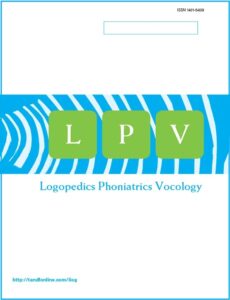Publications

MyotonPRO as a new valid tool for measuring cervical muscle tension. A reliability study.
Authors: Sol Ferran de la Cierva, David Terrasa, Octavio Garaycochea, Beatriz del Rio, Mikel Urdin, Secundino Fernandez
Affiliations: Otorhinolaryngology Department, Clinica Universidad de Navarra, Pamplona, Spain
Journal: Logopedics Phoniatrics Vocology - August 2024 (DOI: 10.1080/14015439.2024.2388896)
-
Field & Applications:
- Medical
- Musculoskeletal disorder
- Orofacial muscles
- Reliability
- The MyotonPRO a useful tool to objectify muscular properties in patients presenting with dysphonia due to muscular tension, as well as for their follow-up and evolution after treatment.
Objective: The main objective of this study is to test the reliability of a non-invasive objective method for the measurement of biomechanical parameters of cervicofacial muscle groups, with the purpose of diagnosis and evaluation of voice disorders’ treatments, especially focused on muscle tension dysphonia.
Study design: Prospective study.
Methods: The device used is a handheld myotonometer (MyotonPRO) that measures biomechanical and viscoelastic properties in superficial soft tissues frequency, stiffness, elasticity, relaxation time and creep. It is used in the field of medicine, sport and research. This pilot study includes 10 subjects, who have been measured in the masseter, sternocleidomastoid, orbicularis oris, semispinalis capitis, suprahyoid, infrahyoid and trapezius muscles on each side. Measurements were performed by 2 evaluators to assess inter-evaluator reliability. Subsequently, one of them repeated the measurements to assess intra-evaluator reliability.
Results: The results revealed good to excellent inter-rater reliability for the masseter, sternocleidomastoid, trapezius and suprahyoid muscles, with lower ICCs for the stiffness and creep properties. Intra-rater reliability was good to excellent for the masseter, sternocleidomastoid, semispinalis capitis and suprahyoid muscles. The lowest ICCs were found in the stiffness and creep properties.
Conclusion: The use of a myotonometer to measure the mechanical properties of selected cervical and orofacial muscles is a reliable and reproducible method. Future research is needed to establish an association between the properties of these muscles and their role in voice disorders, as well as to determine whether this tool can aid diagnosis with quantifiable and objectifiable indicators, and for monitoring and treatment efficacy.
Keywords: myotonometer, MyotonPRO, dysphonia, reliability, muscle tension dysphonia
The use of a myotonometer to measure the mechanical properties of selected cervical and orofacial muscles is a reliable and reproducible method.
Future research is needed to establish an association between the properties of these muscles and their role in Muscle Tension Dysphonia and other cervicofacial disorders, as well as to determine whether this tool can aid diagnosis with quantifiable and objectifiable indicators, and for monitoring and treatment efficacy.
Based on this study and on previous studies, we can conclude that the variables frequency, elasticity and relaxation are reliable and provide objective data on the muscle group measured. Furthermore, the variables that analyze the visco elastic component (creep and relaxation time after mechanical stress) provide additional information. The muscles or muscle groups that could be added in a protocol for the diagnosis of MTD are the masseter, SCM, suprahyoid, trapezius and SCM, although these last three should be analyzed with caution.


